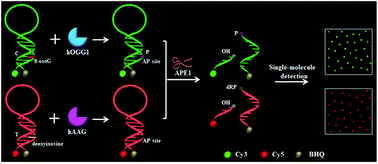当前位置:
X-MOL 学术
›
Chem. Sci.
›
论文详情
Our official English website, www.x-mol.net, welcomes your feedback! (Note: you will need to create a separate account there.)
Simultaneous sensitive detection of multiple DNA glycosylases from lung cancer cells at the single-molecule level†
Chemical Science ( IF 8.4 ) Pub Date : 2017-11-07 00:00:00 , DOI: 10.1039/c7sc04296e Juan Hu 1, 2, 3, 4, 5 , Ming-hao Liu 1, 2, 3, 4, 5 , Ying Li 6, 7, 8, 9, 10 , Bo Tang 1, 2, 3, 4, 5 , Chun-yang Zhang 1, 2, 3, 4, 5
Chemical Science ( IF 8.4 ) Pub Date : 2017-11-07 00:00:00 , DOI: 10.1039/c7sc04296e Juan Hu 1, 2, 3, 4, 5 , Ming-hao Liu 1, 2, 3, 4, 5 , Ying Li 6, 7, 8, 9, 10 , Bo Tang 1, 2, 3, 4, 5 , Chun-yang Zhang 1, 2, 3, 4, 5
Affiliation

|
DNA glycosylases are involved in the base excision repair pathway, and all mammals express multiple DNA glycosylases to maintain genome stability. However, the simultaneous detection of multiple DNA glycosylase still remains a great challenge. Here, we develop a single-molecule detection method for the simultaneous detection of human 8-oxoguanine DNA glycosylase 1 (hOGG1) and human alkyladenine DNA glycosylase (hAAG) on the basis of DNA glycosylase-mediated cleavage of molecular beacons. We designed a Cy3-labeled molecular beacon modified with 8-oxoguanine (8-oxoG) for a hOGG1 assay and a Cy5-labeled molecular beacon modified with deoxyinosine for a hAAG assay. hOGG1 may catalyze the removal of 8-oxoG from 8-oxoG/C base pairs to generate an apurinic/apyrimidinic (AP) site, and hAAG may catalyze the removal of deoxyinosine from deoxyinosine/T base pairs to generate an AP site. With the assistance of apurinic/apyrimidinic endonuclease (APE1), the cleavage of AP sites results in the cleavage of molecular beacons, with Cy3 indicating the presence of hOGG1 and Cy5 indicating the presence of hAAG. Both of the Cy3 and Cy5 signals can be simply quantified by total internal reflection fluorescence-based single-molecule detection. This method can simultaneously detect multiple DNA glycosylases with a detection limit of 2.23 × 10−6 U μL−1 for hOGG1 and 8.69 × 10−7 U μL−1 for hAAG without the involvement of any target amplification. Moreover, this method can be used for the screening of enzyme inhibitors and the simultaneous detection of hOGG1 and hAAG from lung cancer cells, having great potential for further application in early clinical diagnosis.
中文翻译:

在单分子水平上同时灵敏地检测肺癌细胞中的多种DNA糖基化酶†
DNA糖基化酶参与碱基切除修复途径,所有哺乳动物均表达多种DNA糖基化酶以维持基因组稳定性。然而,同时检测多种DNA糖基化酶仍然是一个巨大的挑战。在这里,我们开发了一种单分子检测方法,用于在DNA糖基化酶介导的分子信标裂解的基础上同时检测人8-氧代鸟嘌呤DNA糖基化酶1(hOGG1)和人烷基腺嘌呤DNA糖化酶(hAAG)。我们为hOGG1分析设计了用8-氧代鸟嘌呤(8-oxoG)修饰的Cy3标记的分子信标,并为hAAG分析设计了用脱氧肌苷修饰的Cy5标记的分子信标。hOGG1可能催化从8-oxoG / C碱基对中去除8-oxoG,从而生成一个嘌呤/嘧啶(AP)位点,hAAG可以催化脱氧肌苷/ T碱基对中脱氧肌苷的去除,从而产生AP位点。在嘌呤/嘧啶内切核酸酶(APE1)的协助下,AP位点的切割导致分子信标的切割,其中Cy3指示hOGG1的存在,而Cy5指示hAAG的存在。Cy3和Cy5信号都可以通过基于全内反射荧光的单分子检测简单地量化。该方法可以同时检测多种DNA糖基化酶,检测限为2.23×10 Cy3和Cy5信号都可以通过基于全内反射荧光的单分子检测简单地量化。该方法可以同时检测多种DNA糖基化酶,检测限为2.23×10 Cy3和Cy5信号都可以通过基于全内反射荧光的单分子检测简单地量化。该方法可以同时检测多种DNA糖基化酶,检测限为2.23×10-6 üμL -1为和hOGG1基因8.69×10 -7 üμL -1为Haag的而没有任何靶扩增的参与。此外,该方法可用于酶抑制剂的筛选以及从肺癌细胞中同时检测hOGG1和hAAG,具有在早期临床诊断中进一步应用的巨大潜力。
更新日期:2017-11-07
中文翻译:

在单分子水平上同时灵敏地检测肺癌细胞中的多种DNA糖基化酶†
DNA糖基化酶参与碱基切除修复途径,所有哺乳动物均表达多种DNA糖基化酶以维持基因组稳定性。然而,同时检测多种DNA糖基化酶仍然是一个巨大的挑战。在这里,我们开发了一种单分子检测方法,用于在DNA糖基化酶介导的分子信标裂解的基础上同时检测人8-氧代鸟嘌呤DNA糖基化酶1(hOGG1)和人烷基腺嘌呤DNA糖化酶(hAAG)。我们为hOGG1分析设计了用8-氧代鸟嘌呤(8-oxoG)修饰的Cy3标记的分子信标,并为hAAG分析设计了用脱氧肌苷修饰的Cy5标记的分子信标。hOGG1可能催化从8-oxoG / C碱基对中去除8-oxoG,从而生成一个嘌呤/嘧啶(AP)位点,hAAG可以催化脱氧肌苷/ T碱基对中脱氧肌苷的去除,从而产生AP位点。在嘌呤/嘧啶内切核酸酶(APE1)的协助下,AP位点的切割导致分子信标的切割,其中Cy3指示hOGG1的存在,而Cy5指示hAAG的存在。Cy3和Cy5信号都可以通过基于全内反射荧光的单分子检测简单地量化。该方法可以同时检测多种DNA糖基化酶,检测限为2.23×10 Cy3和Cy5信号都可以通过基于全内反射荧光的单分子检测简单地量化。该方法可以同时检测多种DNA糖基化酶,检测限为2.23×10 Cy3和Cy5信号都可以通过基于全内反射荧光的单分子检测简单地量化。该方法可以同时检测多种DNA糖基化酶,检测限为2.23×10-6 üμL -1为和hOGG1基因8.69×10 -7 üμL -1为Haag的而没有任何靶扩增的参与。此外,该方法可用于酶抑制剂的筛选以及从肺癌细胞中同时检测hOGG1和hAAG,具有在早期临床诊断中进一步应用的巨大潜力。


























 京公网安备 11010802027423号
京公网安备 11010802027423号